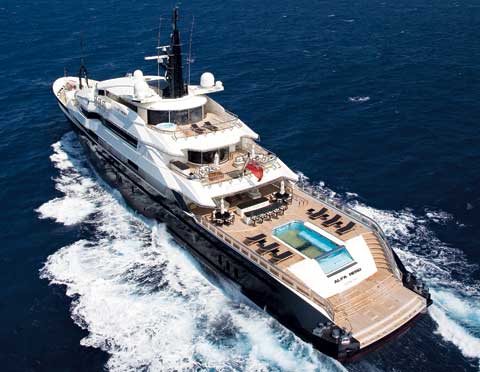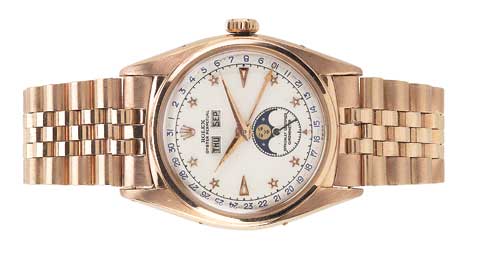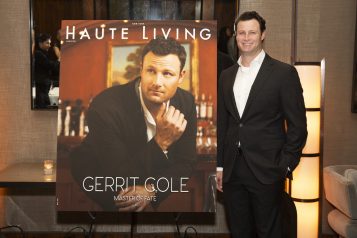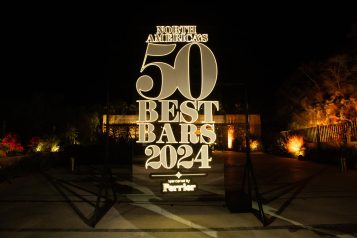Using technology developed and designed by Oceanco’s own team of in-house engineers, a pool of this size has rarely been achieved on such a massive private watercraft.
In 1775, legendary Swedish naval architect Fredrik Chapman (the first to codify hull design based on precise mathematical ratios rather than relying exclusively on empirical methods) contemplated how far the seagoing world had come and where it might head. “If we were to take a view of the immense number of ships that have been built since mankind first began to navigate upon the ocean,” he reflected, “and note all the different steps which have been taken in improving their construction, we should at first sight be inclined to believe that the art of shipbuilding had, at length, been brought to the utmost perfection.” Chapman went on, explaining that this, of course, was anything but the case. Still, he was optimistic that the absolute ideal form for each of mankind’s intentions on the water may yet one day be achieved.
With the 2007 launch of Oceanco’s 269-foot Alfa Nero, that day—at least for the purpose of leisure and water sports—finally arrived.
Don’t just take it as gospel from us. Since headlining the 2007 Monaco Yacht Show, Alfa Nero has enjoyed an endless summer of epic accolades: Yachts International 2007 Most Innovative Custom Motoryacht over 40 meters; Boat International 2008 Best Motoryacht Interior; Boat International 2008 Best Motoryacht Exterior Styling; ShowBoats International 2008 Best Full Displacement Motoryacht over 75 meters; Asia-Pacific Boating 2008 Most Innovative Exterior Yacht of the Year; International Superyacht Society 2008 Best Power Yacht over 65 meters; Boat India ’08 International Boating Awards 2008 Most Innovative Interior Yacht Design.
It is Oceanco’s most celebrated vessel, which is saying something. From 1993’s Indian Achiever (winner of Showboats International 1993 Best Motoryacht Interior award) to 2008’s Anastasia (already shortlisted for 2009 end-of-the-year honors), the Dutch shipyard has been one of the biggest splash-makers in the megayacht sector. Since forming in 1992, it has gained a gold-medal reputation for excellence in gargantuan yet gorgeous luxury vessels, with head-turning designs such as Lazy Z (169 feet), Pegasus (193 feet, 9 inches), Lady Lola (205 feet), Alishar Usmanov’s Dilbar (216 feet), and three 262-footers: Constellation, Stargate, and Lakshmi Mittal’s Amevi. So although Oceanco’s relative existence is a nanosecond on the timeline of mankind’s nautical heritage, the firm nonetheless has advanced custom yacht design by quantum leaps.
With a definitive yet uncomplicated opinion of what a yacht should be, along with a desire to maximize the lifestyle associated with the accessibility of his beloved Mediterranean Sea, a team led by naval architects Carlo Nuvolari and Dan Lenard set aside traditional megayacht design templates, brainstorming a streamlined concept with sleek, open lines free of the top-heavy stacks of vertical superstructure so typical in yacht design. Their vision resulted in the Alfa Nero. A huge proportion of the boat’s length was devoted to a long, low stern. Interior proportions allowed for a reduction of overhangs and consequently more deck space. And instead of a conventional all-white color scheme, they opted for a dramatic black steel hull. The result is a translucent-like frame that reflects gently lapping azure waves like a basalt mirror.
One of the greatest challenges was the owner’s vision for a large pool and a helipad (which also needs a good amount of space) on the main deck, as well as spacious open decks in general. Using technology developed and designed by Oceanco’s own team of in-house engineers, a pool of this size has rarely been achieved on such a massive private watercraft. The unique and complex swimming pool is emblazoned with a large “H” confirmation at its bottom through the clear water. Using the “infinity” design the pool appears, from the stern, to flow endlessly over the horizon. This is accomplished by adding a triangulated glass section where the water streams over, to give a trompe l’oeil impression. The pool can be filled with stored fresh water or with salt water in about 30 minutes. Water that spills over the pool edges is drained back to a balance tank, then routed back to the pool. In a similar way, this is how the pool bottom transforms itself into the helipad. As the hydraulically operated bottom rises, the water above the deck is transferred through channels on the side of the pool to fill the void underneath the “helideck.” Raised and solidly stable, the teak-covered helideck provides an excellent target for a pilot to land a chopper. One caveat: because of the added weight, the chopper is not allowed to deliver passengers, according to MCA code. Nevertheless, it’s a monumental feat that has redefined approaches to outdoor space on yachts.
Other opportunities to help those aboard to truly get away from it all are ever-present. Relaxation and partying are the dominating buzzwords for foredeck amenities, and visual delights abound. Broad, upholstered couches and lounge pads in a matte white, weatherproof material, provide a sentinel’s view to waters yet traversed. A Makassar wood serving table faces a hot tub. In a distant cove with no accessible beach? Not a problem—Alfa Nero simply opens a mid-hull door on the starboard side and out slips its own man-made “beach” platform. This unique concept also allows for loading supplies, or boarding via port craft in any sea combination, without damaging the hull. In terms of water toys, Alfa Nero sports three of them: a Yachtwerft Meyer custom build enclosed limo tender; a Novurania utility tender; and a Ski Nautique 196 limited.
Stepping inside, celebrated Italian designer Alberto Pinto was handpicked to style the yacht’s interior. Given a free reign to create and produce the interior concept, Pinto stated that he wanted Alfa Nero to have a luxurious atmosphere while maintaining a nautical theme. Each guest was to have a unique visual experience in his or her stateroom. To that end, each cabin has a distinctive air achieved through the use of colored leathers and other soft goods. Pinto delivered a contemporary tone replete with focused nuances that are inviting and relaxing without being overpowering. An undersea theme is used on various pieces throughout the yacht.
The dance room is located between the aft deck’s patio seating and the main salon. Hidden sliding glass partitions allow this space to be an extension of the main salon. When the main-deck sliding doors are opened, the entire area from the swimming pool to the main salon becomes a spectacular area for entertaining. The Makassar ebony walls are inlaid with circular “bubbles” of zebrawood that give the rooms an abstract underwater appeal. The main salon also houses an extravagant black-and-white Pleyel grand piano.
The adjacent, main-deck dining rooms, abaft the guest staterooms, can be separated by pocket doors, which, like the walls, are covered in goatskin. The formal dining room seats 14 at an oval table, while a more casual room situated starboard of the centerline seats four in the round. A formal trim makes the space even more tantalizing. The cornice and the mullions feature a special handmade, acid-sculpted glass. Silver leaf is applied to the etched surface to give it a crinkled mirror appearance. Individual squares of the silvered glass are inlaid flush in the Makassar ebony joinery. Enhancing the experience in both dining areas are gunwales that drop down so diners can view the sea. The third dining room is situated in the transition space between the upper salon and the aft deck. The circular area offers a choice of dining either inside or out, depending on which of the sliding glass doors are called into service.
The upper deck is entirely “Mr. A’s” residence. The sky lounge and dining room are surrounded with wengé panels and what has come to be known as the “golf ball” wall: scalloped panels are covered in white lacquer with a mother-of-pearl look, giving the walls a textured effect reminiscent of abstract, flattened golf balls. The wall covering enlarges the room’s appearance and sets the mood to that of a European nightclub, even in the light of day.
In essence, it’s the seemingly endless touches like these that set the ship apart from comers. Chapman, if he were alive today, might agree that wherever one wishes to go, this is the ideal type of vessel to weave a life narrative that is epic, dramatic, and an always hopeful journey of discovery.





















